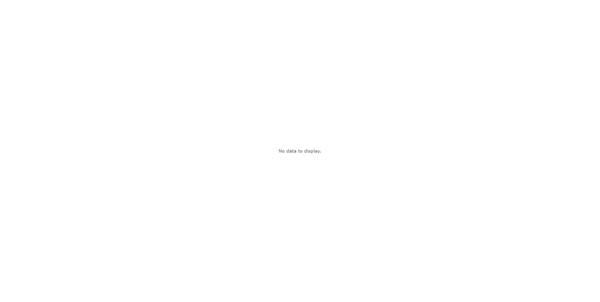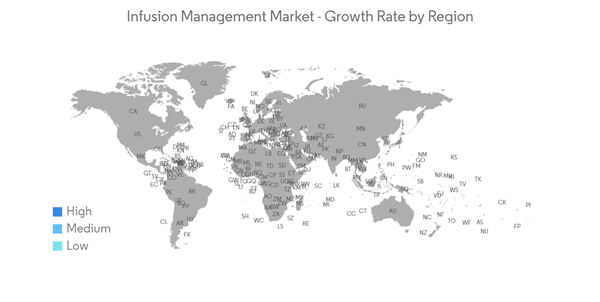The COVID-19 pandemic has impacted the infusion management market. For instance, in 2021, the FDA approved an Emergency Use Authorization (EUA) for intravenous monoclonal antibody therapy. Intravenous (IV) therapy delivers medication directly into the patient's bloodstream. Monoclonal antibodies are designed to block virus attachment and entry into human cells to neutralize the virus. It is designed to limit the replication of the virus, and it was considered effective in treating patients who were at high risk of severe disease from COVID-19. Thus, the use of infusion therapy considerably increased during the initial time of the pandemic. Therefore, with the emergence of the new strain, the market may witness strong growth over the forecast period. However, the crisis of 2020 led to sharp shrinkage in demand, from which the industry is yet to recover fully.
The rising prevalence of various chronic diseases and advancements in technology and healthcare infrastructure are the major drivers for the market. For instance, according to the data published by the International Diabetes Federation in 2021, around 537.0 million adults were living with diabetes. By 2030 around 643.0 million people are expected to live with diabetes. It also reported that 3 out of 4 adults live with diabetes, and around 1 out of 2 adults (240.0 million) were living with undiagnosed diabetes in 2021. The same source also reported that more than 1.2 million adolescents and children are living with type 1 diabetes. Similarly, according to the WHO Report published in June 2021, 39 million children under the age of 5 years were overweight or obese. One in five children and adolescents globally is overweight. Incidences of obesity have been increasing fiercely over the past decades. Infusion therapy is frequently recommended by healthcare professionals in cases of chronic diseases. Therefore, the market is anticipated to witness significant growth over the forecast period owing to such instances.
The advancements in technology and increasing healthcare infrastructure in developed countries are also propelling the market’s growth. For instance, as per the Destatis (Statistisches Bundesamt) data on healthcare expenditure in Germany, published in June 2022, Germany spent around EUR 441.0 billion in the healthcare sector. The expenditure accounted for 13.1% of the nation’s GDP. The Federal Statistical Office (Destatis) reported that this was an increase of EUR 16.3 billion, or 31.5%, compared to 2019. The increase in healthcare expenditure in the nation is expected to add to the market’s growth. Similarly, according to the Eurostat healthcare expenditure statistics published in December 2021, Italy spent more than EUR 155,249 million in the healthcare sector. The increasing healthcare expenditure may encourage many new players to enter the market, which, in turn, will lead to the introduction of new innovative product lines. Therefore, considerable market growth is expected over the forecast period.
However, the high cost associated with the procedure is likely to hinder the market’s growth over the forecast period.
Infusion Management Market Trends
Enteral Nutrition Segment is Expected to Witness Considerable Growth over the Forecast Period
Enteral nutrition therapy, commonly referred to as tube feeding, is the administration of food (formula) through a tube directly into the stomach or intestines. This allows people who are unable to maintain weight and strength through oral intake to receive optimized nutrition. Enteral therapy is always based on the prescription of a qualified doctor. According to the American College of Gastroenterology, there are six main types of feeding tubes. These tubes can have other subtypes depending on where exactly they end up in the stomach or intestines. The placement of the tube will be chosen by the doctor based on what size tube is needed and how long enteral nutrition will be needed. The doctor will also choose the enteral formula to be used based on tube placement, digestive abilities, and nutritional needs.The increasing geriatric population is one of the major drivers for the segment's growth. For instance, as per the report published by the National Commission on Population in India in July 2021, it was estimated that around 138.0 million elderly persons were living in India in 2021, of which 67.0 million were males, and 71.0 million were females. The report also stated that the growth rate of the elderly population was higher than that of the general population and that the elderly population has grown by 36.0% in the last two decades. Similarly, according to the data published by Statistics Canada in September 2022, around 1,879,862 people of age 70 to 74 years were reported in Canada in 2022, whereas in 2020, it was around 1,787,882. Swallowing disorders are common in elderly patients. These can be manifestations of various neurological disorders, but the most common swallowing disorder is deconditioning during an acute illness. Enteral nutrition bypasses the swallowing system using nasogastric tubes or percutaneous gastric and enteral tubes. These nutrition technologies can meet the needs of elderly patients. Therefore, enteral nutrition is an essential part of geriatric medicine. Thus, the increasing geriatric population is expected to impact the segment positively.
The increasing number of cancer cases globally is also propelling the segment’s growth. Similarly, according to the report published by GLOBOCAN 2020, around 2,67,42 cases of prostate cancer, 2,9,929 cases of breast cancer, 14,901 cases of colorectum cancer, 11,227 cases of thyroid, 9,439 cases of cervix uteri, and 103,261 cases of other cancers were reported in Mexico. Enteral Nutrition is an effective method of delivering nutrients into the bloodstream of cancer patients. Providing nutrition through enteral nutrition to cancer patients improves clinical outcomes and is considered more effective than normal feeding. Thus, rising cases of cancer are anticipated to propel the demand for enteral nutrition therapy, thereby propelling segment growth.
Therefore, owing to the aforementioned factors, the segment is anticipated to witness considerable growth over the forecast period.
North America is Expected to Witness Significant Growth over the Forecast Period
North America is expected to witness significant growth in the overall infusion management market over the forecast period. The growth is due to factors such as the rising cases of chronic diseases and the increasing geriatric population in the region. For instance, according to the report published by the 2021 National Census of Canada, seniors over the age of 85 make up one of the country’s fastest-growing demographics. The population of that age group is expected to triple over the next 25 years. Furthermore, according to the Statistics Canada Report published in June 2022, an estimated 233,900 people in Canada will be diagnosed with cancer, and 85,100 cancer-related deaths are expected in 2022. The report also stated that the overall rates of new cancer cases and deaths were declining, whereas the number of cancer diagnoses and deaths continues to climb because of population growth and the aging population in Canada. Thus, such instances indicate that the market is anticipated to witness considerable growth in the North American region.Key product launches, high concentration of market players or manufacturers’ presence, acquisitions, and partnerships among major players, and rising cases of chronic diseases in the United States are some of the factors driving the growth of the infusion management market in the country. Furthermore, according to the National Cancer Institute, the number of cancer survivors is expected to rise to 22.2 million by 2030. The most common cancers in the United States are breast cancer, lung cancer, prostate cancer, colorectum cancer, bladder cancer, and skin cancer. Thus, such factors are anticipated to propel the demand for infusion therapy in the country.
Therefore, owing to the factors mentioned above, the growth of the market studied is anticipated in the North American Region.
Infusion Management Market Competitor Analysis
The infusion management market is fragmented in nature due to the presence of several companies operating globally as well as regionally. The competitive landscape includes an analysis of a few international as well as local companies which hold market shares and are well known, including Becton, Dickinson and Company, McKesson Corporation, Polymedicure, Terumo Medical Corporation, and Optum Inc., among others.Additional benefits of purchasing the report:
- The market estimate (ME) sheet in Excel format
- 3 months of analyst support
This product will be delivered within 2 business days.
Table of Contents
Companies Mentioned (Partial List)
A selection of companies mentioned in this report includes, but is not limited to:
- Becton, Dickinson and Company
- Terumo Medical Corporation
- Medtronic PLC
- McKesson Corporation
- BIO-MED
- Polymedicure
- Optum Inc.
- Fresenius Kabi AG
- ICU Medical Inc. (Smiths Medical)
- B. Braun SE
- Baxter










